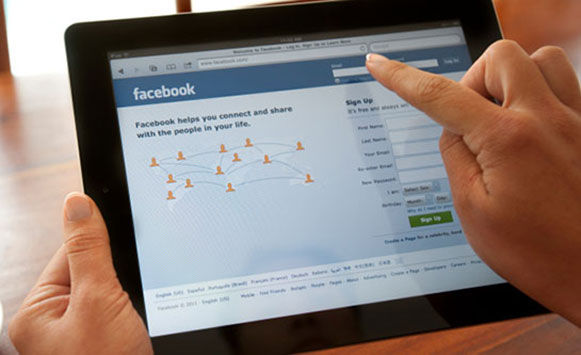
Ranging from proud declarations of reaching weight-loss goals to daily “gym time!” announcements, it seems like everyone is using social media to tout their accomplishments (or share photos of their meals, healthy or not). There are some obvious reasons why someone might choose to do this, including a desire for social support and undoubtedly a bit of self-congratulations, but is there also a downside to forging a quest to lose weight in so public a forum, especially since statistics show that so many dieters and exercisers eventually give up?
If your Facebook newsfeed looks anything like mine, scattered among the political rants and baby photos are nutrition- and workout-related posts from family and friends. Ranging from proud declarations of reaching weight-loss goals to daily “gym time!” announcements, it seems like everyone is using social media to tout their accomplishments (or share photos of their meals, healthy or not).

The Importance of Social Support
According to the ACE Health Coach Manual, social support from family and friends is an important predictor of physical-activity behavior. It is difficult for an individual to maintain a lifestyle-modification program if he or she does not have support at home or at work. The use of online social media broadens this concept and enables users to reach hundreds of friends instantaneously. It takes the idea of making yourself accountable to a friend by scheduling a morning walk and multiplies it a hundredfold. “It’s about accountability,” explains Hani Skyles, who is using social media to garner support for his weight-loss efforts. “I have friends who post daily like I do and I make a point of ‘liking’ any fitness-related post. It’s a simple way of acknowledging their efforts.” It’s what Dr. Mantell calls a “virtual high five.”
There are some obvious reasons why someone might choose to do this, including a desire for social support and undoubtedly a bit of self-congratulations, but is there also a downside to forging a quest to lose weight in so public a forum, especially since statistics show that so many dieters and exercisers eventually give up? I spoke with Michael Mantell, Ph.D., Senior Fitness Consultant for Behavioral Sciences for ACE, and Chris Freytag, well-known fitness expert and Chair of the ACE Board of Directors, about the benefits and potential drawbacks of using social media for both clients and fitness professionals.
Charlie Vecchio posts every few weeks or so with a new weight-loss total—to date, he’s down 90 pounds on a mission to shed an even 100. Every time he posts an update, he gets dozens of comments of support and amazement, which no doubt serve to inspire him to keep going.
On the other end of the spectrum, Hani Skyles is in the early stages of behavioral change and uses his nightly announcements of “Gym time!” to make himself feel accountable to his circle of online friends and keep himself on track. Each time he successfully makes it to the gym counts as a small victory that helps him stay motivated—a process focus, unlike Charlie’s progress focus. The clear upside to these posts centers around the social support that is so vital to weight-loss success. But is there more to it?
According to Dr. Mantell, there are two reasons that fitness professionals and exercise enthusiasts use social media to discuss physical activity and nutrition: “(1) to motivate themselves and garner social attention and external motivation, and (2) to motivate others toward a healthy lifestyle.” He then pauses and adds a third reason: Passion! “Most of these people don’t need someone to ‘like’ their commitment to exercise in order to maintain their motivation levels. They simply love to talk about exercise and are truly passionate.”
Here are some tips from Freytag and Dr. Mantell for more effectively using social media:
- The first step in effectively using social media is to have a plan. According to Dr. Mantell, fitness professionals need to know how they can use social media to their advantage, and they need a plan for climbing the social media mountain. He recommends creating YouTube videos, then promoting them on Facebook and Twitter. “You don’t have to think about it in terms of sales,” he says. “Give quality information and education, and success will come. You can market health, fitness and wellness by educating.” Freytag agrees with Dr. Mantell. “A fitness professional can be a content provider, answer questions, provide news updates and offer motivational quotes.” It is important to focus on health, but Freytag says it’s okay to occasionally sell yourself or your services by offering Facebook-friend discounts or Twitter giveaways. “This can be done in a way that is not overbearing and is respectful of other users’ time.”
- Fitness professionals should avoid using glamour shots (unless you want to be a celebrity bodybuilder or model), as this can be intimidating and turn off a lot of potential clients. Also, fitness pros should avoid narcissistic grandiosity. Consider someone who posts “Just finished a 7-mile run. Off to bootcamp… wish me luck!” He or she probably wants to revel in the amazed responses from friends and clients, not motivate or inspire. In fact, this would probably scare off some potential clients.

- There is value in the app market. Fitness professionals can generate conversation by using and recommending smartphone apps. Most people who utilize social media do so in many forms. In addition to being faithful Facebook users, Skyles and Vecchio both use multiple fitness-related apps, including running logs, 5K training programs and calorie-counter apps. The possibilities are truly endless and always expanding, so there is a lot of room for creativity in this area.
- Dr. Mantell recommends that fitness professionals use SMART goal-setting language—specific, measurable, attainable, relevant and time-bound—when posting about their own workouts. This reminds friends and clients of the importance of knowing the goal of each workout and helps establish you as an authoritative voice, which should be the ultimate objective for any fitness pro.
- Don’t forget that social media is a two-way street, says Freytag. For example, consider a client who has been slow to lose weight despite completing some pretty intense workouts over the past six weeks. His Facebook profile may reveal a pattern of dinners out on the weekend or multiple happy hours each week. Without embarrassing the client, the fitness professional can introduce the use of a food log to trigger a discussion of the importance of making wise nutritional choices.
- Freytag recommends that fitness professionals introduce online challenges and create private groups of like-minded individuals. For example, she has had great success with a 28-day weight-loss challenge. She starts by inviting clients to the group, and then encourages them to invite their own friends and family—thereby introducing herself as a reliable fitness expert to entirely new circles of potential clients. More importantly, she creates an avenue for tremendous social support.
- Think before you post. Freytag advocates giving something concrete for people to respond to. While “Gym time!” may be helpful for the average user, fitness professionals should be more thoughtful in their posts.
- It is of the utmost importance that fitness professionals respect their clients’ privacy. There are more private ways to encourage clients, so you should never say something in a public forum that may embarrass anyone.
The Benefits of Social Media for Clients
For some users of social media, “Gym time!” is the equivalent of “Sitting down for my morning coffee” or a check-in from the local Target store—who cares? And why are you cluttering my newsfeed? But it’s important to realize that such fitness-related posts may be fueled by a very specific motivation beyond the need for social support. For Skyles, the reason he started making these posts was to remind loved ones that he’s making the effort, and that he wished they would do the same.
For Vecchio, “the posts are all about accountability.” Vecchio—a former college athlete and member of the U.S. Army—has lost these same 90 pounds in the past, but quickly regained them. This time around he’s motivating himself to stay on track—he’s already kept the weight off longer than with previous attempts—by having so many friends invested in the process. He’s also inspired a few to join him and, as his weight has fallen, friends have reached out to him for advice.
When it comes to his own workouts, Dr. Mantell will often post the details of an upcoming visit to the gym, including specific exercises and the goal of that workout. Some of these posts will garner almost no response, while others generate multiple responses, and sometimes even a workout partner or two. He says that there is definite value in this type of post “in terms of motivation, planning and accountability.” Looking back through your own online history can also be great for personal tracking purposes, as it can give you a glimpse of what has and has not worked for you in the past.
The Flipside: Posting Negative Behavior
There is another point where social media and health behaviors intersect—when a person posts photos or shares stories of him- or herself engaging in unhealthy behaviors. Consider someone struggling with obesity sharing Instagram photos of huge restaurant desserts or a weekly purchase at the local bakery.

Dr. Mantell attributes this type of online behavior to a quest for attention at any cost. The person is hoping someone will say, “Oh, that’s ok… I do it too” or “Isn’t that dessert great?” or offer gentle, loving disapproval. In other cases, the person could be asking for help. “It’s important for fitness professionals to know that this is not innocent,” says Dr. Mantell. “Remember, this is a multistep process, starting with taking the photo, approving of that photo and then taking the time to actually share it. The person could back out of that process at any point, so this really may be a cry for help.”
A more subtle example of the downside of social media is exemplified by Skyles, who admits that he sometimes shies away from posting photos of himself if he has gained a few pounds. He’s justifiably proud when he loses 10 or 15 pounds and is excited to share that news, so if he gains 5 of those pounds back, he doesn’t like to post photos until he’s shed the weight again.
According to Dr. Mantell, this is not the best response. “It’s important to remember that everyone lapses,” he says. So if Skyles has 300 Facebook friends, nearly every one of them can undoubtedly relate to his experience. Consider if he reposted this along with his photos: “I regained 5 of those 15 pounds. Time to get back on track and step up the intensity of my workouts! I’ve lost the weight before, so I know I can do it again.” This puts things into real-life perspective and can be a very powerful motivator for many people, including those family members that Skyles is trying to inspire. Dr. Mantell says, “Weight gained is an opportunity to challenge your thinking about the inevitable failures and successes that everyone has. When you don’t hit a goal or have a brief lapse, post something that demonstrates kindness to yourself.” Remember, the ultimate goal is to improve health and long-term fitness, not to attain perfection.
One final tip, and this holds true whether you are posting in your role as a fitness professional or simply killing some time online, is to take a moment to “like” or comment on the fitness-related posts of your friends, family members or clients. A little social support—a virtual high five—is an essential component of nearly everyone’s long-term success.

 by
by 





